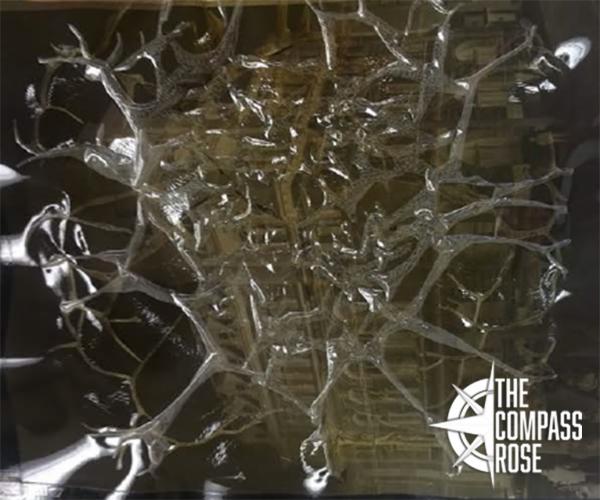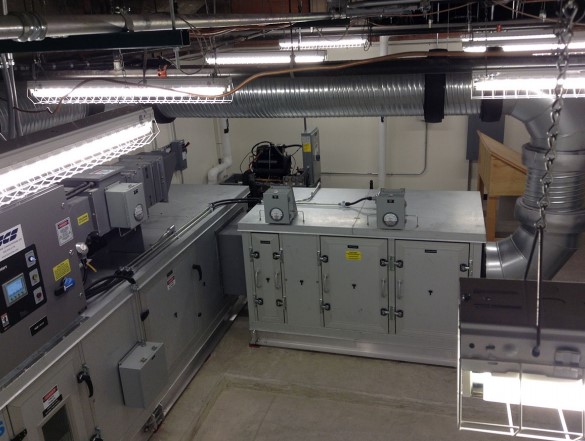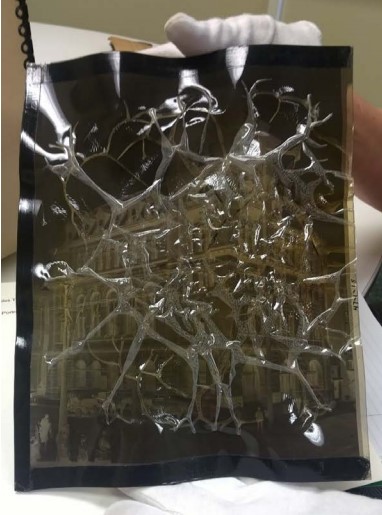
by Stephanie Luke


by Stephanie Luke
The purpose of The Compass Rose is to raise awareness of Special Collections' resources and to foster the use of these resources. The blog series also reports significant new programs, initiatives, and acquisitions of Special Collections.
Today, Special Collections presents a special guest post from Art History undergraduate student Allyson Frizzell. She discusses the ongoing significance of art and archival conservation measures undertaken by Special Collections.
Anyone who visits Special Collections has the benefit of accessing a massive and diverse supply of interesting works on paper. Through an Independent Study this semester, I have had the pleasure of working with many of the paper objects housed at Special Collections to develop my skills in art and archival conservation methods.
Today, we expect paper to be produced from trees (and we lament loss of forests), but paper hasn’t always been made from wood. In the 1840s, there was a general shift in paper production from cotton rag pulp (which is relatively chemically stable) to aluminum sulfate and wood pulp. This production choice led to alarming rates of paper decay, as these materials significantly increase the pH of the paper over time. As a result of increased acidity, paper produced from the mid-nineteenth to mid-twentieth centuries often becomes brittle far more quickly than paper produced earlier. The work of William Barrow of Virginia State Library in the 1960s provided explicit evidence of this phenomenon, stimulating advances in the production and conservation of paper (Allman, et al. 1991). Alkaline additions have increased the longevity of paper, significantly slowing decay rates compared to that of paper produced from the mid-19th to mid-20th centuries. Archives generally contain aged or aging paper works, so collaboration with conservation professionals is crucial for preservation of cultural history.
Responding to Barrow’s work in the 1960s, the National Endowment for the Humanities has devoted considerable funds to preservation and conservation initiatives in libraries, archives, and other cultural institutions that address these conservation needs (Allman, et al. 1991). Libraries that actively engage in preservation efforts spend around 5% (or more) of their annual budget on preservation materials and treatments (NEDCC 2015). According to the American Institute for Conservation’s national survey in 2018, around 45% of practicing conservators list “books and paper” or “photographic materials” as their primary discipline, and around 46% of conservators stated that they work in libraries, archives, and universities (MDWG 2018). These professionals ensure culturally valuable documents and works on paper are not lost to the gradual passage of time.
The Special Collections archive provides access to a substantial wealth of manuscripts, maps, and other primary source documents on paper. Their Texas Disabilities History collection is one of very few disability collections in the country. General histories of Texas and Mexico are especially well represented in various broadsides, sheet music, letters, and government documents. Special Collections’ Star Telegram collection is an immense and unique photographic history of Fort Worth and Tarrant County frequently utilized by patrons. Recent donations from Dr. Jack Franke, an alumnus of UTA, have allowed Special Collections to offer access to extensive examples of the cartographic history of Africa, further expanding the cultural and geographic scope of the archive. These collections all contain items of priceless cultural and historic significance, motivating and necessitating Special Collections’ ongoing investment in conservation and preservation.
Their endeavors to conserve various archival items have prevented major cultural losses, largely through grants and the donations of generous individuals and groups. Examples of smaller, more common preservation measures include removal of harmful adhesives and humidification to relax tightly rolled paper. In addition, Special Collections has worked with conservators to undertake more significant treatments of specific works; for example, a priceless broadside of the Texas Declaration of Independence was sent to conservator Cheryl Carrabba in Austin, Texas, in 2019 for removal of its decaying silk backing, revealing copious annotation on the back side of the sheet (fig. 1). This example demonstrates the value of conservation as a method of both preserving and expanding cultural knowledge.

Figure 1: Annotations discovered on the back of the Texas Declaration of Independence broadside at UTA Special Collections. Photo by author, 2021.

Figure 2: Cold vault mechanical room equipment installed by Scientific Climate Systems, May 1, 2015. Image Source: McClurkin 2015.
Removal of the silk backing on the Texas Declaration of Independence is an example of interventive conservation, whereby individual objects are directly altered via treatment of some kind to halt causes of decay. Conservation practices also rely on preventive preservation measures to ensure long-term sustainability of such important collections, generally through implementation of appropriate storage environments. The University of Texas at Arlington Libraries made a commitment to preventive preservation in 2015 with the construction of a cold storage vault on campus (fig. 2). The main purpose of the vault is to slow the process of irreversible vinegar syndrome (the shrinking and warping of photographs due to acids) affecting much of the collection of Star Telegram negatives (fig. 3).

Figure 3: 8 x 10 inch W. D. Smith acetate negative exhibition vinegar syndrome. Image source: McClurkin 2015.
No monetary value can be assigned to the potential cultural loss had the cold storage vault not been implemented; however, it is estimated that 10-20% of negatives from 1950 or earlier would be completely lost to decay each decade (McClurkin 2015). Scanning and digitization of the collection, along with the labor required to complete it, was estimated to cost around $97 million over the span of up to 30 years (Ibid.). By moving the negatives to the cold vault and slowing deterioration significantly, Special Collections has ensured that there will be enough time to properly parse through the collection and select which items warrant digitization. The cold vault also halts the degradation of the envelopes in which the negatives are stored, preventing additional acid buildup and eliminating the costs of replacing the vast number of individual envelopes and enclosures.
In addition to history and art fields, conservation of Special Collections’ paper and photos is concerned with chemistry and molecular decay and is therefore applicable to STEM research. Interesting collaborations are possible at junctions of academic specialties, and Special Collections is able to provide valuable experience and information to students and faculty of a wide variety of interests. Much of the technology and techniques used in conservation analysis are adopted from other fields. For example, x-ray fluorescence spectrometry and polarizing light microscopes are used in many disciplines such as chemistry, geology, archaeology, among others. Potential collaboration between Special Collections and STEM researchers at UTA would provide students with unique opportunities to study chemistry and physics as they affect real-world items over time. Greater campus-wide involvement in conservation, preservation, and analysis of Special Collections’ materials will spread general awareness of the archives, diversifying and increasing the number of people invested in the archive’s continuing development and protection.
Conservation and preservation are essential functions of most archives, and Special Collection’s history of engagement with these practices has benefited the university in many ways, including for individual students. Through my work with Special Collections, I have developed contacts with various local conservators. I also have gained valuable experience with archival materials, such as wheat paste adhesive and buckram cloth, used for preservative measures. Preliminary technical experience is required for anyone to gain admittance to graduate programs in conservation, and Special Collections has been an extremely valuable first step in acquiring skills and information on my path to grad school. My work with the archive represents an example of the conjunction of STEM and history disciplines; increased attention to conservation would continue to provide more students with exceptionally valuable and interdisciplinary opportunities.
Allman, Miriam H., Robert L. Buckwalter, Kenneth E. Carpenter, et al. 1991. "Appendix 2: The acidic and brittle paper problem and its solutions" in "Preserving Harvard's retrospective collections". Harvard Library Bulletin no. 2: 69-70.
McClurkin, Brenda S. 2015. “Creating Cold Storage Vault to Preserve Archival Collections Related to Texas History.” White Paper PF-50176-11, University of Texas at Arlington, November 30, 2015.
MDWG (Membership Designation Working Group). 2018. “Member Designation Survey Preliminary Report,” American Institute for Conservation of Historic and Artistic Works: 17-23.
NEDCC (Northeast Document Conservation Center). 2015. “Session 9: Building a Preservation Program,” Northeast Document Conservation Center: Accessed April 19, 2021. https://www.nedcc.org/preservation101/session-9/9program-funding
Comments
Wonderful work!
Look forward to more STEM and Arts collaborations in Special Collections!
Add new comment